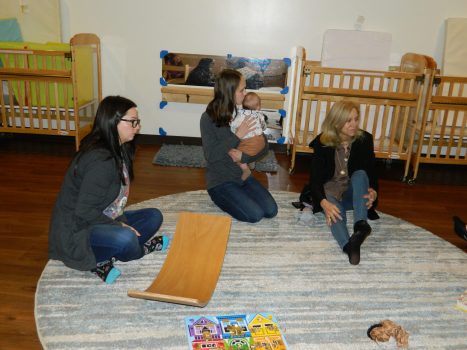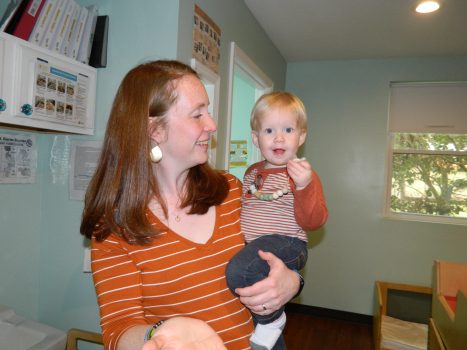Speaking without words: Sign language for infants and toddlers can be beneficial
Published 12:10 am Tuesday, March 12, 2024
SALISBURY — Learning to communicate not vocally but using signs was the lesson of the day Saturday in the infant room at the Yadkin Path Montessori School on Bringle Ferry Road, a lesson geared toward this very young age group.
Katelyn Boggs, the director of the Salisbury school, has always had an interest in sign language and said it was a “self-driven interest, self-taught.” So she learned the alphabet and, when she had children of her own, taught them signs, knowing “how beneficial it was to be able to give them a method of communication before their mouth and tongue and motor skills are fully developed,” and she is now passing that knowledge to others.
“I think that as early as you want to begin using signs would be beneficial for sure, and then you can just expand on it as the child demonstrates readiness,” Boggs said.
Sign language can help give children earlier access to language, Boggs said, as she told that all four of her children, now ages 7, 5, 3 and 17 months, learned the sign for milk early, about 9 to 10 months old. When they cried, and she ran through the list of possible needs, she asked if they wanted milk, and “they would be able to do the sign for milk, and let me know that’s what they needed.”
The use of signs can help both the child and the adult, as she said it can help them understand the needs of the child and reduce frustration.
Another benefit could be because hand and wrist control develop sooner than the motor and oral skills that are necessary for talking, she said.
Using signs with the very young is “helpful for children who are developing typically as well as atypically and children who are having oral/motor issues or speech delays that continue using sign language into preschool years while they are working with the speech therapist,” Boggs added.
The Montessori classroom, which has a goal of promoting concentration, can also benefit from using sign language.
“We want the children to be able to focus on what they are doing. We don’t want to do anything or allow anything to happen that will interrupt them. Anything as simple as calling across the room to a child can break the concentration of those who are working. So it’s really beneficial, especially in situations like that where you are trying to communicate without using speech.”
Boggs also mentioned some studies showing that “children who learn and are able to understand and communicate with signs actually have increased cognitive development because it’s building mirror pathways sooner than speech would.”
Children learn from their environment, she said, what they see and hear is being absorbed in their mind, and “there’s also something in the brain called mirror neurons where the child sees something and will copy it. Mirror neurons start working very early,” Boggs said, telling of how she and her son when he was just a baby used to stick their tongues out at each other. “It’s just a really simple form of connection and communication.”
Ryann-Rebecca Montgomery chuckled as she said that was happening with her son Miles Fen, who was being taught that same thing by her mom, Barbara Montgomery.
“That’s those mirror neurons that are firing. You can see it happening and so then his brain is trying to copy it,” Boggs said.
It’s the same with mirror neurons and signs, she continued. “It’s a lot harder to learn to speak just by watching someone’s mouth, but if someone were to use the sign for milk” whenever feeding the baby, they would associate that with milk.
A lot of repetition and being intentional with your words and your signs, using them together, are important and helpful in the learning process, she said, and in teaching the class the signs, that is what they did as they learned and reviewed thus reinforcing the learning process.
Many basic signs were taught to begin with including milk, please, more, all done, thank you, eat and water.
Just as when a child is learning to speak, and it’s not clear, so also their attempts at the signs will not be as clear either, and Boggs stressed them watching closely for their attempts and what looks intentional as they make the signs and then encourage and accept the attempt, which she said happened with her son Ronan learning the sign for water. Instead of the three fingers making the letter ‘W’ he used just one, but she recognized his attempt.
Additional signs that they might find helpful were shared during the class, ranging from book, sorry, wash and diaper to home, mom, dad and grandparents.
She then asked class members if they had any words they wanted to learn while there and once again reiterated the need to keep repeating these words and signs with the children.
Those in attendance decided to come to the class for various reasons. Because the school uses sign language, Hannah Cook, one of the infant guides there, attended because she wanted to learn sign language so “I can incorporate it with the kids in the classroom to be able to communicate better with them.”
The children in her class, she said, range in age from 12 weeks to about a year and a half.
Montgomery said she wanted “to have early communication with” her son, to which her mom said “we both believe in it and it really helps” also telling that she would be helping take care of the baby later and thus their both knowing the signs would reinforce each other’s efforts.
Nicole Jones, who serves as the president of the Friends of Yadkin Path nonprofit, said that this is the first class of its kind being taught on the weekend, and they made the decision to offer it because they “were trying to come up with different classes, and this is something that not a lot of people know.”
And secondly, because the school uses it, they wanted to try to include it so the parents could also learn it.
While no additional sign language classes have been scheduled as of now, Boggs said they would follow up as the need arose, and they could offer follow up classes or provide another repeat of this beginner class as well.





